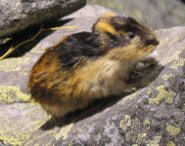 The Norway lemming (Lemmus lemmus) is a common type of lemming found in the tundras of Scandinavia and Western Russia. Norway lemmings are generally 13 to 15 centimeters (about 5 to 6 inches), with an added tail length of 2 centimeters (0.8 inch), and range in weight from 28 grams to 113 grams (1 to 4 ounces).
The Norway lemming (Lemmus lemmus) is a common type of lemming found in the tundras of Scandinavia and Western Russia. Norway lemmings are generally 13 to 15 centimeters (about 5 to 6 inches), with an added tail length of 2 centimeters (0.8 inch), and range in weight from 28 grams to 113 grams (1 to 4 ounces).Besides its namesake country of Norway, these lemmings are found in Sweden, Finland, Western Russia, and a number of islands outlying from these countries. They live in a number of habitats, including grasslands, shrubs, and occasionally wetlands. They are fully comfortable in snow, and during the winter, tunnel along the ground underneath the snow in order to find food and shelter. Their fur is waterproof, and grows thicker in the winter, so they are not affected as dramatically by the snow. When the snow melts during the summer, the Norway lemmings will burrow underground to build nests, and line them with grass for insulation.
Their diet consists primarily of the grasses, shrubs, and moss around them, although in the summer they will eat insects as well. Because of their small size, they are prey to a number of animals, notably, owls, buzzards, skua (or jaegers), wolverines, foxes and ermines.
Norway lemmings are not currently endangered, and are in fact classified as a species of least concern by the International Union for the Conservation of Nature and Natural Resources, which produces the well known "Red List" of threatened species. However, there is some concern about the lemming's status in light of global warming, with the BBC reporting in 2008 that climate change is causing lemmings to have less swarming years, and leading to a lighter snowfall. This leads to a reduction in the thick, insulating snow layer, which makes it harder for the Norway lemmings to survive the winter, and a correspondingly lower population.
The Norway lemming is listed as Least Concern (LR/lc), lowest risk. Does not qualify for a more at risk category. Widespread and abundant taxa are included in this category, on the IUCN Red List of Threatened Species
Some facts about the
Norway lemming
Adult weight : 0.07 kg (0.154 lbs)
Maximum longevity : 3 years
Female maturity :24 days
Male maturity : 44 days
Gestation : 19 days
Weaning : 15 days
Litter size : 7
Litters per year : 3
Interval between litters : 26 days
Weight at birth : 0.004 kg (0.0088 lbs)
Basal metabolic rate : 1 W
Body mass : 0.08 kg (0.176 lbs)
Temperature : 37.85 °C (100.13 °F)

Custom Search